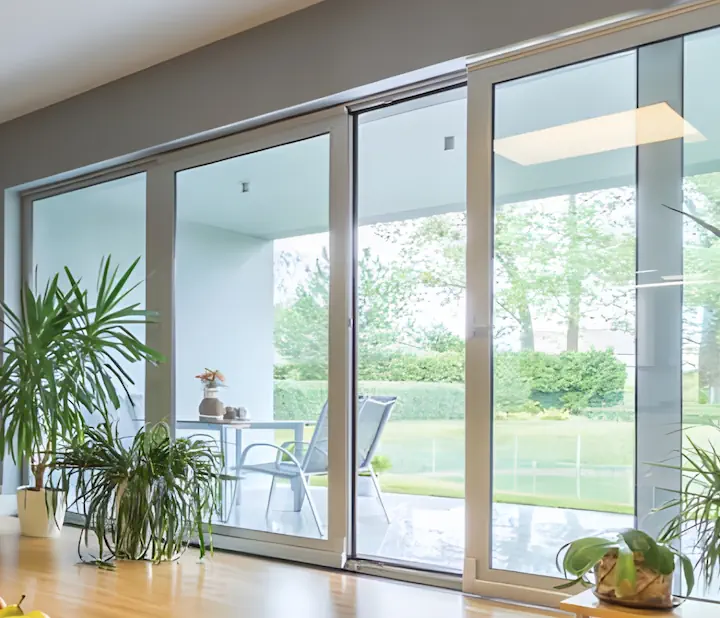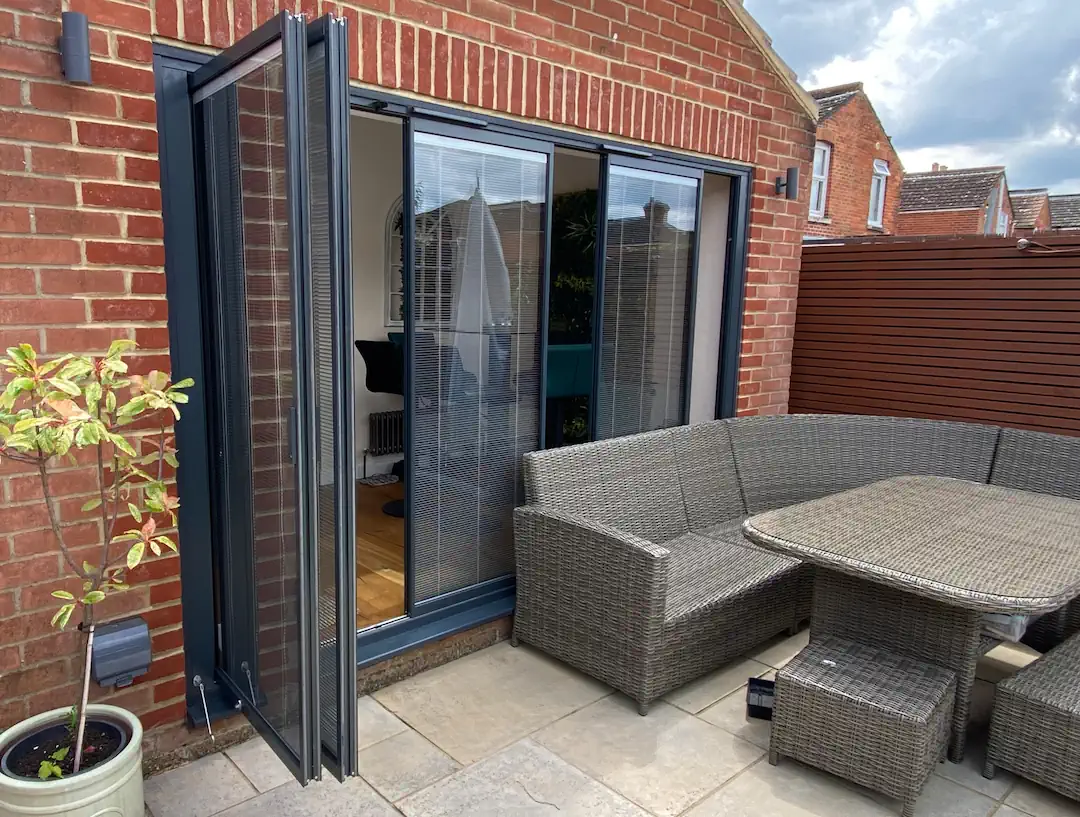Alternatives to Bifold Doors for Homes
Table of Contents
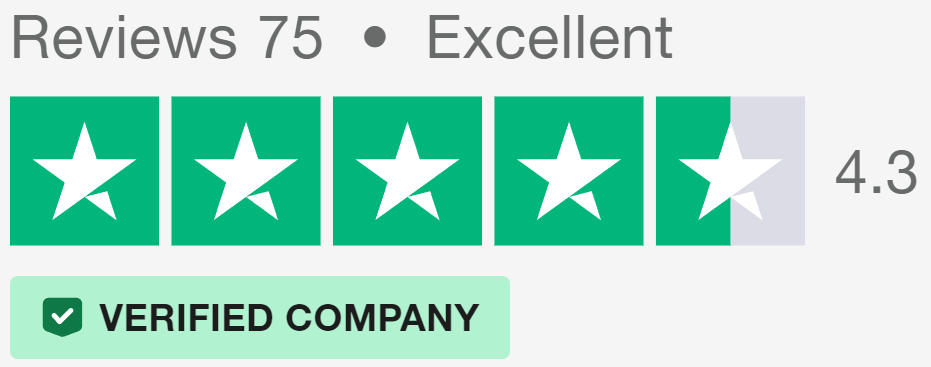
Introduction
Over the past few years, many alternatives to bi fold doors (also known as concertina doors or folding doors) have become available, with various mechanisms. This evolution in door design provides homeowners with more versatile and practical options. From sliding and pivot doors to pocket and slide and turn doors, each of the many types of doors brings its own set of advantages. These newer door styles address the limitations of bi-fold doors, offering improved functionality and a fresh look.
Drawbacks of Bifold Doors
Space Consumption
Bifold doors can take up a lot of space when fully opened. This can limit where you place furniture and reduce usable living areas. The panels fold back on themselves, creating bulk that might not be suitable for tighter spaces.
Maintenance and Durability
Keeping bifold doors in good shape can be a hassle. The tracks easily collect dirt, and hinges may need regular lubrication to work smoothly. Over time, these parts can wear out, leading to frequent repairs. Also, maintaining the correct alignment is crucial for proper operation, which can be challenging.
Cost and Installation
Installing bifold doors often requires professional help due to their complexity. Misalignment can cause operational issues, so a skilled installer is essential. This, along with the high cost of the doors themselves, makes bifold doors an expensive choice. Custom sizes or materials can drive the price even higher, making them less appealing for those on a budget.
Sliding Doors
Sliding doors offer a practical and stylish alternative to bifold doors. Their design provides various benefits, making them a popular choice for modern homes.
What Are Sliding Doors?
Sliding doors operate by moving horizontally along a track, rather than swinging open. This mechanism allows for a smooth and effortless transition between indoor and outdoor spaces. They typically consist of large glass panels that slide past each other, providing an unobstructed view when closed.
Sliding Doors: Advantages
One of the main advantages of modern sliding doors is their space efficiency. Since they do not swing open, they save valuable floor space. This makes them an ideal choice for smaller rooms or areas where space is at a premium. Additionally, sliding doors often feature large glass panels, which increase the amount of natural light entering a room and provide expansive views of the outside.
Another benefit is their ease of use. Sliding doors glide along tracks with minimal effort, making them user-friendly for people of all ages. They also offer excellent insulation options, with many models designed to keep homes warm in the winter and cool in the summer. For accessibility, flush or low threshold sliding doors are widely available.
Sliding Doors: Downsides
One issue is the limited opening width, as typically only half of the doorway can be opened at any time. This might not be ideal for homes that need a wide opening for ventilation or movement.
Maintenance can also be a concern. The tracks need to be kept clean to ensure smooth operation, and the rollers may require periodic replacement. Additionally, sliding doors might not provide the same level of security as other options, although modern designs have improved significantly in this regard.
Slimline Sliding Doors
Slimline sliding doors offer a modern and elegant solution for homeowners looking for alternatives to bifold doors. These doors are designed to maximise light and space, creating a sleek and contemporary look.
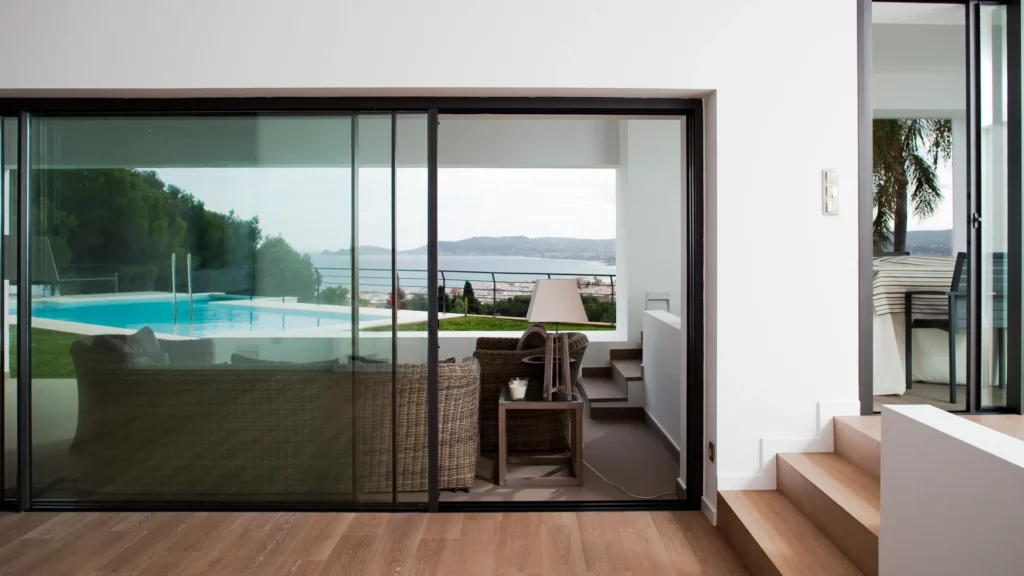
What Makes Slimline Sliding Doors Different?
Slimline sliding doors are characterised by their narrow frames and large glass panels. The reduced frame size allows for more glass, providing unobstructed views and increased natural light. These doors operate on a similar mechanism to standard sliding doors but focus on minimalistic design and maximised glass area.
Slimline Sliding Doors: Pros
One of the primary benefits of slimline sliding doors is their ability to make a room feel more spacious and open. The large glass panels allow more light to flood into the space, creating a bright and airy atmosphere. The narrow frames provide a minimalist aesthetic, fitting well with modern and contemporary home designs.
Slimline sliding doors are often made with high-quality materials that offer excellent insulation properties. This means they can help maintain a comfortable indoor temperature, reducing energy costs. Their sleek design also requires less visual and physical space compared to bulkier door options.
Slimline Sliding Doors: Cons
While slimline sliding doors have many advantages, there are some considerations to keep in mind. These doors can be more expensive than standard sliding doors due to the specialised materials and design. Installation may also require professional expertise to ensure proper alignment and functionality.
The large glass panels and narrow frames need to be supported adequately, which might necessitate additional structural adjustments to your home. Ensuring that these doors are compatible with your home’s architecture is essential.
Slimline sliding doors provide a stylish and practical alternative to bifold doors, especially for homeowners seeking to increase light and space in their living areas. They combine functionality with a modern aesthetic, making them a desirable choice for many.
Pivot Doors
Pivot doors are a striking alternative to bifold doors, offering a unique blend of style and functionality. Their distinctive design can become a focal point in any home, providing both practical and aesthetic benefits.
How Do Pivot Doors Work?
Pivot doors rotate on a central hinge, allowing them to open and close in a smooth, sweeping motion. Unlike traditional hinged doors, which are attached at the side, pivot doors are anchored at the top and bottom. This design allows for larger, heavier doors that can make a bold architectural statement.
Pivot Doors: Benefits
Their unique opening mechanism allows for wide, unobstructed access, which can be particularly useful in larger spaces or for homes with substantial indoor-outdoor connections. The central pivot point enables the door to handle more weight, allowing for the use of robust materials such as steel or solid wood.
Aesthetically, pivot doors provide a modern and sophisticated look. Their seamless operation and minimalist design can complement a variety of architectural styles, from contemporary to industrial. Moreover, pivot doors can be customised in terms of size, material, and finish, offering flexibility in design choices.
Pivot Doors: Drawbacks
Pivot doors also come with some potential downsides. Their larger size and heavier materials can make them more expensive than other door types. Installation requires precise alignment and professional expertise, which can add to the overall cost.
Space can also be a concern with pivot doors. The door’s arc requires ample clearance, which might not be suitable for smaller rooms or tight spaces. Additionally, the top and bottom pivot points need to be securely anchored, which may require structural modifications to your home.
Pivot doors are a distinctive and functional alternative to bifold doors. They provide wide openings and a modern look, though they come with considerations regarding space and cost. For homeowners looking to make a bold design statement, pivot doors can be an excellent choice.
Pocket Doors
Pocket doors offer a clever and space-saving alternative to bifold doors. Their design allows them to disappear into the wall, providing a clean and unobtrusive solution for various home spaces.
What Are Pocket Doors?
Pocket doors slide into a compartment within the wall when opened, rather than swinging outwards or folding. This design effectively hides the door when it’s open, saving space and creating a streamlined look. They are often used in areas where space is at a premium, such as small rooms, closets, or between connecting rooms.
Advantages of Pocket Doors
Since they slide into the wall, they do not take up any floor space when open. This makes them ideal for small rooms or areas where traditional doors might be cumbersome. Also, pocket doors provide a smooth and clean look, as they are completely hidden when not in use.
Pocket doors also offer flexibility in design. They can be made from a variety of materials, including wood, glass, or metal, and can be customised to fit any décor style. This versatility makes them suitable for both modern and traditional homes.
Disadvantages of Pocket Doors
The installation process is more complex compared to other door types, as it involves creating a cavity within the wall. This typically requires professional installation and can be more costly and time-consuming.
The hidden tracks and mechanisms are harder to access, making repairs and adjustments more challenging. Over time, debris can accumulate in the track, affecting the door’s operation.
Not all walls can accommodate pocket doors, especially those that are load-bearing or contain plumbing and electrical systems. This limitation can restrict where pocket doors can be installed in a home.
Pocket doors are an innovative and practical alternative to bifold doors, particularly in spaces where saving floor area is crucial. While they require careful planning and professional installation, their space-saving benefits and sleek appearance make them a desirable option for many homeowners.
Slide and Turn Doors
Slide and turn doors, also known as slide and stack or slide and pivot doors, offer a flexible and modern alternative to bifold doors. These doors combine the advantages of sliding and folding mechanisms, providing a versatile solution for various home settings.
What Are Slide and Turn Doors?
Slide and turn doors consist of multiple panels that slide along a track and stack neatly at the end of the opening. Unlike traditional bi-folding doors, these panels can pivot and slide independently, allowing for a wide range of opening configurations. This design maximises the opening space and offers excellent flexibility.
Benefits of Slide and Turn Doors
The ability to open and close individual panels allows homeowners to control the amount of space they want to open. This feature is particularly useful for creating a large, open entrance or a smaller passage, depending on the need.
Slide and stack doors also provide an unobstructed view when fully opened, as the panels stack neatly to the side. This design is ideal for homes with beautiful outdoor views or for spaces that require a wide opening. These doors are also available in various materials and finishes, allowing for customisation to match any home style.
The frameless variants of slide and turn doors offer an even more modern look.
Disadvantages of Slide and Turn Doors
Homeowners should consider the installation requirements and costs of slide and turn doors. These doors can be more slightly expensive than other alternatives due to their complex mechanisms and customisation options. Professional installation is often necessary to ensure proper alignment and smooth operation.
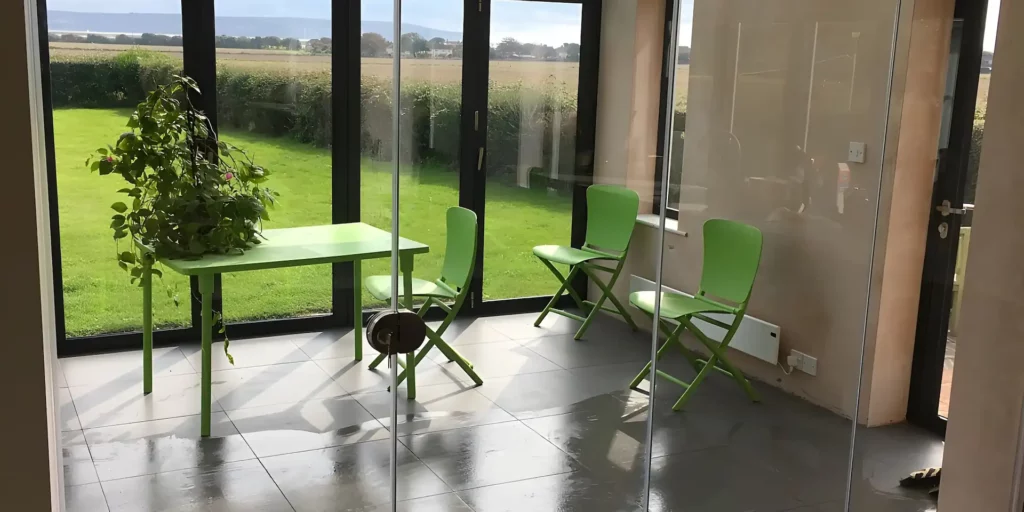
Frameless Slide and Turn Doors
Regular slide and pivot doors have visible frames that provide additional support and durability. These frames can be customised to match the home’s design, offering a balance between aesthetics and functionality. They are generally more robust and easier to install than frameless versions.
Frameless slide and stack doors, on the other hand, offer a sleeker look with no visible framing around the glass panels. This design provides a more contemporary appearance, ideal for modern homes. However, frameless doors may require more precise installation and may not be as durable in high-traffic areas.
Slide and pivot doors offer a flexible and stylish alternative to bifold doors, suitable for various home settings. Whether choosing regular or frameless variants, these doors provide a versatile solution for creating open, airy spaces with minimal visual barriers.
Frequently Asked Questions
What are the best bifold door alternatives?
Sliding doors are a common, and often cheaper alternative to bifold doors, valued for their space efficiency and sleek appearance. Pivot doors offer a striking alternative for those wanting a bold architectural feature. Pocket doors are perfect for tight spaces, as they slide into the wall, freeing up floor space. Lastly, slide and stack doors provide a flexible solution, allowing for wide openings and unobstructed views.
How do sliding doors compare to bifold doors?
Sliding doors offer a more space-efficient bifold doors alternative, as they slide along a track and do not intrude into the living space. This makes them easier to maintain and operate. Bifold doors, on the other hand, provide a wider opening when fully retracted, which can be beneficial for larger spaces. Sliding doors also tend to have a more streamlined appearance, which suits modern homes.
What is the difference between regular and frameless slide and turn doors?
Regular slide and turn doors (also known as slide and stack doors or slide and pivot doors) have visible frames that provide additional support and durability. These frames can be customised to match the home’s design, offering a balance between aesthetics and functionality. Frameless slide and turn doors, however, offer a sleeker look with no visible framing around the glass panels. This design provides a more contemporary and minimalistic appearance but may require more precise installation.
How do I choose the right door for my space?
Choosing the right door for your space involves considering several factors, including the size of the opening, the desired aesthetic, and practical needs. For smaller spaces, pocket doors are ideal as they save floor space by sliding into the wall. For larger openings, pivot doors or slide and stack doors can provide a dramatic and functional solution. Also, consider the style of your home and the level of maintenance each door type requires.
What are the disadvantages of bifold doors?
Bifold doors have several disadvantages, including their tendency to consume floor space when open, making them less ideal for smaller rooms. They also require regular maintenance due to the multiple hinges and tracks, which can become clogged with dirt. Also, bifold doors can be expensive to install, especially if custom sizes or materials are needed, and may not provide as tight a seal as other door types, affecting energy efficiency.
What are the latest trends in door design?
Current door design trends emphasize clean lines and efficient use of space. Slimline sliding doors are gaining popularity for their minimalistic frames and large glass panels. Pivot doors are also trendy, providing a bold and contemporary look. Sustainable materials like reclaimed wood and energy-efficient designs are becoming more common, reflecting a growing interest in eco-friendly home improvements.
How do I measure for new doors?
Measuring for new doors involves taking precise measurements of the existing door frame. Measure the width at three points—top, middle, and bottom—to check for any variations. Similarly, measure the height from the floor to the top of the frame on both sides and in the centre. Use the smallest measurement to ensure accuracy. Don’t forget to account for the thickness of any flooring or carpeting that might affect the door’s fit.
What are the common issues with bifold doors?
Bifold doors often face several common issues such as misalignment, making them hard to open and close smoothly. Dirt and debris can accumulate in the tracks, causing operational difficulties. The hinges and rollers are prone to wear and tear, necessitating regular upkeep. Moreover, bifold doors may not seal as tightly as other types, potentially resulting in drafts and reduced energy efficiency.
What are the energy efficiency considerations for different door types?
Energy efficiency varies widely among different door types. Sliding doors with double-glazed glass and insulated frames can offer good thermal performance. Pivot doors, if well-sealed and made from insulating materials, can also be energy-efficient. Pocket doors may have gaps that allow drafts, so ensuring they are properly sealed is crucial. Slide and stack doors with quality seals and insulated glass can also contribute to energy efficiency, reducing heat loss.
How do I ensure the security of glass doors?
To ensure the security of glass doors, use laminated or tempered glass, which is more resistant to breakage. Install high-quality locks, such as multi-point locking systems, and consider adding a security film to the glass to prevent shattering. Using security bars or grills can provide an extra layer of protection. Motion sensor lights around the doors can also deter potential intruders.
What are the best styles of doors for modern homes?
For modern homes, doors with minimalist and contemporary designs are preferred. Sliding doors are a top choice for their streamlined appearance and efficient use of space. Pivot doors, known for their dramatic and stylish look, are also popular in modern settings. Frameless glass doors offer a sleek and seamless design.
Need Help Deciding?
Vision Glass Doors is a designer, manufacturer, and installer of premium door systems. We are a family run business with over 20 years’ experience and 5,000 installations across the UK.
Our doors have gone through rigorous security testing and successfully passed PAS-24 certification. This is a requirement by law for all new-build homes.
All our systems are made to measure, designed, and fabricated at our manufacturing facility in Luton, Bedfordshire. We offer installation within a 100-mile radius.
Our leading range of door systems include Ultra Slim – Slide and Turn Doors, Slimline Sliding Patio Doors and Frameless Glass Doors. Suitable for various internal and external applications, they are applicable to residential and commercial projects.
Click Quick Quote Online for a free quotation within 24 hours. Alternatively, call or email us on 01582 492730 or at info@visionglassdoors.co.uk.


